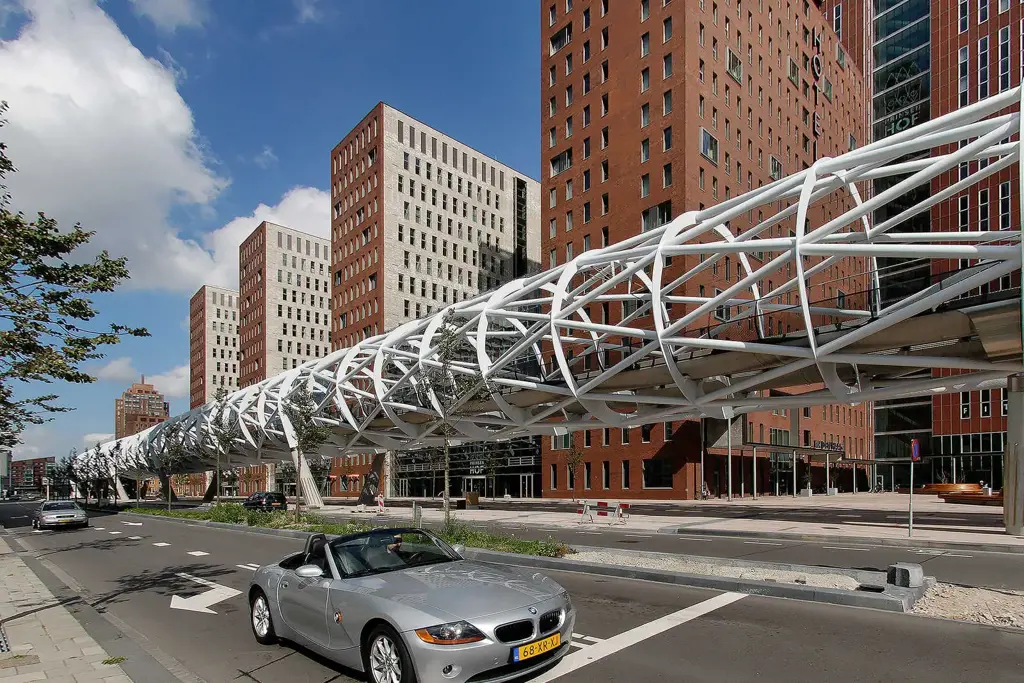RandstadRail Station Beatrixlaan, Den Haag
Description
Passen en meten
Om de wijk Beatrixkwartier beter bereikbaar te maken met openbaar vervoer was er een aansluiting nodig op het netwerk van Randstadrail. In dit dichtbebouwde gebied moest een viaduct met een nieuw station langs de Beatrixlaan komen. Er was weinig ruimte, omdat een tweerichtingsweg en een fietspad dezelfde route volgen. Om een asymmetrische lay-out te verkrijgen, moesten deze twee worden omgeleid.
Architectenbureau ZJA ontwierp een vierhonderd meter lang lightrail-viaduct én het station en baseerden zich daarbij op twee uitgangspunten. Ten eerste, moest het hele bouwwerk niet ogen als een ruimtelijke en visuele belasting, als een zware sta-in-de-weg, maar als een lichte, open constructie die beweging, verbinding en energie uitstraalt. Ten tweede zou de aanleg van spoorviaduct en station aangegrepen moeten worden om een nieuwe en eigen identiteit aan de openbare ruimte toe te voegen.
De constructie en het beeld
Om voetgangers, fietsers en automobilisten vrij zicht te laten houden was een hoog viaduct wenselijk. Hoe minder kolommen er waren om het gevaarte overeind te houden hoe beter. En dat betekende dat de buis waardoor de trein rijdt zelf zo hoog, stijf en sterk moest zijn, dat grote overspanningen mogelijk werden. De constructie die ZJA daarvoor bedacht bestaat uit enorme stalen ringen met een doorsnee van tien meter, die veertig en vijftig meter uit elkaar staan, gedragen door V-vormige kolommen. De ringen zijn verbonden door diagonaal geplaatste buizen. Zo ontstaat er een sterke maar open buisconstructie, die zich bij de halte verdikt, als een boa constrictor die een varkentje heeft ingeslikt. Het is een ontwerp dat gebaseerd is op het vinden van een doelmatige en functionele constructie, maar die een esthetisch en zelfs vrolijk, sexy beeld oplevert. De bijnaam voor dit viaduct was al snel De Netkous.
De toekomst van onze steden ligt in het bereikbaar en leefbaar houden van de alsmaar dichtere structuur. Voetgangerszones, fietspaden, groen en openbaar vervoer zijn daarvoor noodzakelijk. Het viaduct op de Beatrixlaan laat zien dat zulke noodzakelijke en efficiënte infrastructuur een aantrekkelijke en esthetische toevoeging aan de stad kan zijn. Dan kunnen zo ook opvallend en wit zijn.
Nieuwe plekken
Een halte van Randstadrail in een wijk levert ook een kans om de openbare ruimte te verlevendigen en te verbeteren. Ook daarop speelt het ontwerp van ZJA in. Om te beginnen ligt de buis met de trein niet tussen de auto’s, maar hangt ie boven de stoep. De opvallende vormen van de buis bevinden zich dicht op de gebouwen. Dit is openbaar vervoer en dat hoort bij de voetgangers, bij de gebruikers van de gebouwen.
Omdat het viaduct hoog is, ontstaan er rond de halte plein-achtige openbare ruimtes, waar ook is voor plantsoenen met struiken en bomen. Het station is asymetrisch opgezet, zodat de perrons diagonaal tegenover elkaar liggen en ook de ruimte op straat meer zichtlijnen en openheid heeft. Het spoor in de buis rust op een betonnen bed, waardoor een groot deel van het geluid en de trillingen worden geabsorbeerd.
Met dit opvallende ontwerp, geïnspireerd op de Buckytube van Buckminster Fuller, en de L-train in het centrum van Chicago, heeft het Beatrixkwartier een karakteristieke blikvanger gekregen. Voor inwoners en bezoekers van Den Haag is het een herkenbaar en aantrekkelijk bouwwerk dat door iedereen gebruikt kan worden.
Architect: ZJA
Klant: Gemeente Den Haag
Aannemer: Ballast Nedam
[English]
A narrow fit
To improve accessibility by public transport to the Beatrixkwartier in The Hague, connectivity with the RandstadRail network was needed. In this dense urban area a new and elevated station had to be developed along the Beatrixlaan. Space was scarce, as a two-way road and a bicycle path follow the same route. To obtain an asymmetrical layout these two had to be re-routed.
ZJA’s design for an elevated lightrail viaduct over 400 meters and the station is based on two principles. First, the entire construction was not to appear as a spatial and visual obtrusion, as a heavy obstacle, but rather as a light and open construction that emanates movement, connectivity and energy. Secondly, the construction of the elevated lightrail and the station should be used as an opportunity to create a new and attractive identity for the public space in the neighbourhood.
The construction and the appearance
The elevation was designed to make sure pedestrians, cyclists and motorists alike maintained an unobstructed view. The fewer columns necessary to support the enormous construction, the better. That meant the tube through which the train moves had to be high, strong and stiff to allow for a large span. ZJA designed a construction consisting of huge steel rings with a diameter of ten meters, set apart forty to fifty meters and supported by V-shaped columns. The vertical rings are connected by diagonally placed tubes. This creates a strong but open network of tubes that widens at the section where the station is, like a boa constrictor after having swallowed a piglet. This design is the result of a quest for an efficient and functional construction but offering an aesthetic, even joyful, sexy image all at the same time. It did not take long for the elevated light rail to acquire a nickname: The Fishnet Stocking.
The future of our cities lies in keeping their increasingly dense structure accessible and pleasurable to live in. Pedestrian zones, bicycle paths, parks and public transport are necessary to achieve that. The elevated light rail along the Beatrixlaan shows that such necessary and efficient infrastructure can be an attractive and aesthetically pleasing addition to the city. That kind of infrastructure can then also afford to be conspicuous and painted white.
New spaces
Building a new station of the Randstadrail in a neighbourhood offers the opportunity to improve and vitalise public spaces. This is an additional feature of ZJA’s design. First of all, the tube construction containing the train is not located in between the cars, but hovers above the sidewalk. The characteristically shaped tube is positioned close to the buildings. Public transport should belong to the users, the pedestrians, who are also the visitors of the buildings.
The height of the elevated light rail creates square-like public spaces in the vicinity of the station, with enough room for green patches with trees and shrubbery. The station has an asymmetrical lay out, placing the platforms diagonally opposite to each other, all intended to provide more sight lines and an open architecture. The rails inside the tube rest on a separate concrete foundation, absorbing most of the sound and shock waves.
With this striking design, inspired by Buckminster Fuller’s Bucky Tube and the L-train in downtown Chicago, the Beatrixkwartier has gained an iconic landmark. For residents and visitors of The Hague it is a recognisable and attractive structure, open to all.
Architect: ZJA
Client: The municipality of the Hague
Contractor: Ballast Nedam
Expertise: Architecture Features or Specials: Structural design Awards: Nominatie: Neprom-prijs 2007, Winnaar: Routepluim 2008, Nominatie WAN Urban Design Award 2009, Nominatie Gebouw van het Jaar 2007, Nominatie Nationale Betonprijs 2007

Werk ook slimmer met Galleo
Galleo brengt projectdata, kennis en AI samen in één veilige, schaalbare oplossing. Toonaangevende bedrijven zoals ABT, Movares, CLAFIS en Witteveen+Bos kiezen al voor Galleo. Sluit je aan.
Neem contact op met Barbara of Kars
We werken zelf in de gebouwde omgeving en adviseren je graag, met praktijkervaring en vakkennis, over wat het beste werkt voor jouw organisatie.
Neem contact op